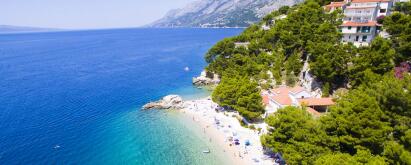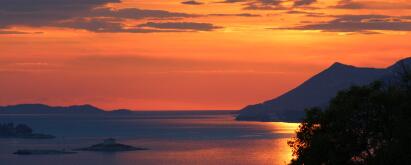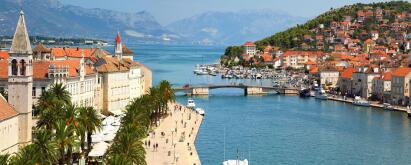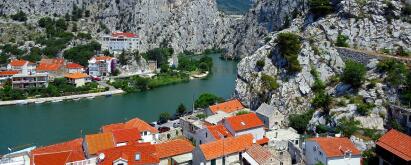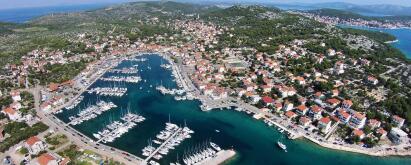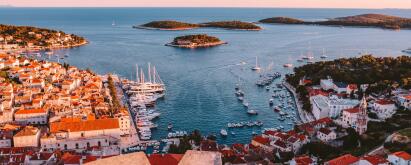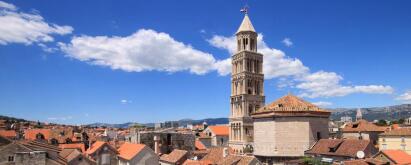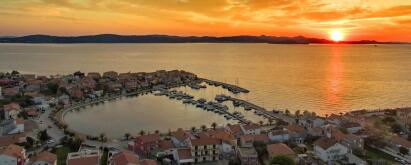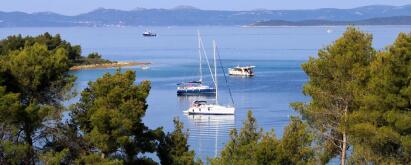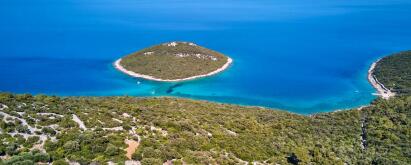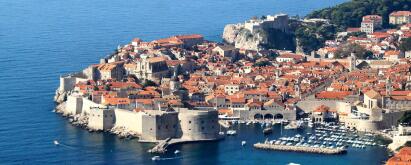Culturele topevenementen in Kroatië die u niet mag missen - II. deel
Gepubliceerd: 17-09-21
In het tweede deel van het artikel vervolgen we onze reis langs culturele evenementen in Kroatië. Deze keer bezoeken we de eilanden, gluren in het binnenland Istrië en ontdek atypische theatervormen, de grootste watersportcompetitie, ga terug naar de middeleeuwen op Rab of maak deel uit van het gekste verkleedfeest van Kroatië!
8. MOREŠKA KORČULA
Korčula is een eiland met een ongelooflijk rijke geschiedenis, cultuur en tradities die van generatie op generatie worden doorgegeven. Volgens de legende is het het thuis van de legendarische ontdekkingsreiziger Marco Polo, evenals van oude culturele evenementen en tradities die de lokale grenzen overstegen. Een van deze tradities is de ridderdans Moreška, die deel uitmaakt van het immaterieel cultureel erfgoed onder bescherming van UNESCO.
Moreška is een traditionele ridderdans met zwaarden die Kroatië bereikte aan het einde van de 13e eeuw. Op Korčula wordt het onafgebroken uitgevoerd van de 15e eeuw tot vandaag. Het is een trotse traditie van het eiland Korčula, die de succesvolle opstand tegen het koloniale gezag van de Moros viert. Vroeger werd het overal in Europa uitgevoerd, maar tegenwoordig is het alleen op Korčula te vinden, waar het wordt uitgevoerd door 9 dansgroepen van het eiland!
Tegenwoordig is Moreška een festival dat duurt van juni tot midden september. Het dansprogramma is het centrale onderdeel van het festival en iedereen kan eraan deelnemen. Volgens de traditie wordt Moreška uitgevoerd op 29 juli, de feestdag van de heilige Teodor, de beschermheilige van het eiland. De dans wordt echter meerdere keren per week uitgevoerd voor alle bezoekers en alleen door mannen.
De eerste gedateerde vermeldingen gaan terug naar de 17e eeuw, toen er twee varianten van de dans bestonden: Moreška met twee zwaarden en Kumpanija en Moštra met één zwaard. Het is vooral een dramatisch-scène vertoning die muzikale, tekstuele en choreografische elementen combineert. In de Moreška zijn er 4 hoofdpersonages: de zwarte en witte koning, Otmanović en Bula. Bula is het enige ongewapende vrouwelijke personage rond wie twee legers zich afspelen.
Het inleidende gedeelte is dramatisch en wordt uitgevoerd door de zwarte koning en Bula, waarna de dans volgt. Hieraan nemen 24 moreškanta deel, verdeeld over 8 choreografische eenheden. Het muzikale gedeelte bestaat uit 40 muzikanten, 40 koorleden en 30 folkloristische leden.
In het Stedelijk Museum kunt u een permanente tentoonstelling bekijken die al het materiaal van het eiland verzamelt, inclusief fragmenten van de Moreška. Als u op het eiland bent in juni, mis dan de Nieuwjaarsviering Halverwege niet voor het wildste zomerevenement!

9. RAPSKA FJERA

Als je van de middeleeuwen, geschiedenis en tradities houdt, dan is de Rapska fjera van 25 tot 27 juli het evenement voor jou! Deze traditie is bijna 800 jaar oud! Het wordt gevierd ter ere van heilige Christoffel en Lodewijk de Grote, die het eiland bevrijdden van de bezetters. Vroeger duurde de fjera 14 dagen.
De Rapska fjera is het oudste en grootste middeleeuwse festival in Kroatië. Gedurende drie dagen wordt het eiland overspoeld door meesterlijke ambachtswinkels, fabrieken en ambachtelijke winkels die het leven van de oude tijden reconstrueren. De straten klinken van traditionele muziek en dans, en de voorbijgangers kunnen genieten van middeleeuwse lekkernijen en lokale producten. Probeer zeker de šulčići en rapska torta.
De fjera begint met de bijeenkomst van de „officiële organen” en deelnemers van de Rapska fjera, die naar het centrum van de stad gaan, verlicht door fakkels. Onderweg stoppen ze in de parochiekerk voor een zegen, waarna ze verder gaan naar Varoš. Daar wordt hun ontvangen door de burgemeester in de rol van hertog, zijn plaatsvervanger, notaris en rechter. Na registratie in het Fjera-boek en een kanonschot, begint het festival officieel.
De eerste avond is elegant, de tweede heeft een visserskarakter en de derde is ridderlijk en competitief. Dit is tevens de belangrijkste avond waarop de dag van heilige Christoffel, de beschermheilige van het eiland, wordt gevierd. Aan het einde trekt een kostuumoptocht naar het Hertogelijk Paleis, waar de vlag wordt neergelaten en het vuurwerk de lucht verlicht, wat het einde van het festival aankondigt.
De spelen worden gehouden sinds 1995 en kunnen meerdere keren per jaar worden georganiseerd voor feestdagen en vakanties. De fjera heeft de „Blauwe Bloem”-prijs gewonnen, de hoogste onderscheiding, en wordt bijgewoond door ongeveer 60 culturele en artistieke verenigingen uit Kroatië.
Naast het dramatische optreden zijn er veel dingen te zien op de Rapska Fjera. Op de Pijaceta kun je wijn, kaas, olijfolie, rakija, vijgen proeven en aromatische kruiden kopen, en oude ambachten en objecten ervaren. De Zee Promenade viert het vissersleven, het agrarische verleden van het platteland, terwijl de Kathedraal het ontmoetingspunt is voor schilders en kunstenaars. Vergeet niet om de gastronomische aanbiedingen te proberen in de lokale restaurants, die in deze 3 dagen uitsluitend middeleeuwse gerechten bereiden!
10. RIJEČKI FESTIVAL
Er is niemand op de wereld die zich niet minstens één keer heeft verkleed en op "jacht" ging naar snoepjes. De traditie van verkleden en carnaval is zo oud als de mensheid zelf. Het is wereldwijd verspreid en zo populair dat de maand februari wordt beschouwd als de maand van het carnaval!
Carnavals worden overal in Kroatië gehouden, maar er is er maar één die wereldwijd bekend is. Dat is het Rijecki carnaval, de kleurrijkste, vrolijkste en meest innovatieve carnaval hier. Het belang ervan ligt in het feit dat het op satirische en ironische wijze de samenleving, lokale identiteit en de levensstijl en cultuur van de stad, regio en het land beschrijft.
Het symbool van het carnaval zijn de zvončari (beldragers) die met hun geluid de boze geesten verdrijven en de start van het carnaval aankondigen. Ze staan onder bescherming als onderdeel van het UNESCO immaterieel cultureel erfgoed. Hoewel de traditie al teruggaat tot de 19e eeuw, werd deze pas de afgelopen 30 jaar vernieuwd op initiatief van lokale enthousiastelingen. Inmiddels is dit kleine lokale evenement uitgegroeid tot een van de grootste in Europa, met meer dan 100.000 bezoekers!
Het hoofdprogramma is de internationale carnavalsoptocht die op de laatste zondag van februari plaatsvindt. Na de optocht begint het feest dat duurt tot de vroege ochtend. Het Rijecki carnaval is tegelijkertijd een wedstrijd in originaliteit en innovatie, evenals een tentoonstelling van traditionele en carnavalsgroepen. Hier worden het traditionele en moderne gecombineerd, waarbij nieuwe carnavals ontstaan op de basis van oude waarden en gewoonten.
Naast de identiteits-, culturele, artistieke en sociale rol, is het Carnaval een reflectie, kritiek en ironisch commentaar op de actualiteit en het dagelijks leven. Daarom trekken de maskers elk jaar veel aandacht van het publiek en worden ze het onderwerp van discussies in de weken daarna. Vaak veroorzaken ze mediahypes en controverse. Het is dan ook niet verwonderlijk dat verkleden vroeger verboden was! Maar in wezen gaat het om vermakelijke volksverhalen die het dagelijks leven ironiseren, en plezier en lachen zijn het enige doel van het Carnaval. Het Rijecki carnaval is bekend geworden doordat het een chic stadsfestival combineert met dat gebaseerd op mythologie, folklore en oude tradities.

Een programma voor iedereen met gegarandeerd plezier, gelach en gezelligheid
Naast de optocht is het festival rijk aan inhoud en programma. Voor de jongsten is er de Kindercarnavalsoptocht, waarmee Rijeka verandert in een stad uit een sprookje. Personages uit stripboeken, romans, films en series vermaken de kleintjes en brengen de geest van de carnaval over op de komende generaties.
Het meest interessante deel van het festival is het wedstrijdgedeelte. Dit gaat vooral over de keuze van de carnavalskoningin voor de prestigieuze titel „Gouden Mantel”. Het masker dat wordt gekozen, wordt het symbool van de carnaval voor dat jaar. Daarnaast wordt ook de beste groepsperformantie geselecteerd. Daarna overhandigt de burgemeester van Rijeka symbolisch de sleutels van de stad aan Meester Carnaval, en de komende maand wordt Rijeka het epicentrum van het wilde feest!
Wat je zeker goed zal laten lachen is de „Paris-Bakar” Rally, een parodie op de bekendste rally ter wereld. Kostuumdragers en auto’s rijden door de stad in de grappigste race die je ooit zult zien. Ook is de Rijecki Carnaval de enige die sneeuwplezier biedt nabij de zee. Voor iets compleet anders kun je de Carnival Snowboarding Session bezoeken en genieten van de stuntwerk en het afterparty voor de boeken.
Om af te sluiten moet je je goed vermaken. Dat zal te danken zijn aan het Rijecki Carnival Party, georganiseerd naar het voorbeeld van de Berlin Love Parade. Hiermee wordt multiculturalisme en vrijheid gevierd door middel van een geweldig feest, muziek en sociale interactie. Doe mee en onthoud, „Krepat, ma ne molat!” wat het motto is van het festival dat de sociale normen tart en ironisch de dagelijkse realiteit beschrijft.
Jaarlijks nemen meer dan 100 groepen en 10.000 deelnemers deel aan het Festival. Honderdduizenden mensen volgen het carnaval live, en nog veel meer via digitale kanalen. Daarom werd Rijeka in 1995 opgenomen in de Association of European Festival Cities als een top cultureel evenement.
Vanwege zijn populariteit wordt het Carnaval ook wel het vijfde seizoen genoemd, omdat gedurende een maand Rijeka de belangrijkste plek voor plezier wordt, waar andere regels gelden dan elders. Durf je eraan, kom en volg het festivalmotto „Wees wie je wilt zijn!” en „Wees jezelf!” en word deel van het leukste gemaskerde avontuur!
11. MARATON LAĐA

Vroeger was het gebied langs de rivier de Neretva een vruchtbare regio die duizenden mensen voedde, maar vandaag de dag is het een onontdekte toeristische parel. Een van de evenementen die bijdraagt aan de internationale erkenning is de Maraton Lađa, die gehouden wordt op de laatste zaterdag van augustus. In 23 jaar is het uitgegroeid tot het belangrijkste culturele evenement van deze regio.
Het is een amateurrace van traditionele roeiboten over een afstand van 22,5 kilometer. Maar liefst 400 roeiers doen mee aan de race op de rivier de Neretva, van Metković via Opuzena naar Ploča. Het wordt beschouwd als het grootste maritieme sportevenement, dat jaarlijks tot 50.000 bezoekers trekt!
Het echte spektakel begint al bij de start, wanneer 33 boten de rustige rivier omtoveren tot een wilde stroom, tot groot enthousiasme van het publiek. Het tempo vertraagt zelden, en het belangrijkste is dat elke ploeg in dezelfde type boot roeidt, wat betekent dat vaardigheid en uithoudingsvermogen de sleutel tot de overwinning zijn. Het team bestaat uit 10 roeiers, een trommelaar en een stuurman. In Opuzenu is het toegestaan om tot 6 vervangingen te doen. Alle boten zijn houten boten, die met traditionele methoden zijn gebouwd en een precies aantal ribben hebben.
De regels van de wedstrijd zijn strikt: naast de boten moeten de roeiriemen en stuurwiel van hout zijn, de roeiers moeten met hun voeten in het water staan, de trommelaar zit in het midden en er moeten altijd 10 roeiriemen in het water zijn. Aanvankelijk mochten alleen roeiers uit de regio deelnemen, maar door de populariteit van het evenement is de Maraton Lađa tegenwoordig van internationale betekenis. Voor een eerlijke race mag het maximum aantal boten 33 zijn. Alleen de snelsten kunnen deelnemen, en de winnaar ontvangt gouden medailles en de schild van prins Domagoja van brons.
De Maraton Lađa begon in 1998 als een idee van een aantal sport- en geschiedenisliefhebbers. Inmiddels is het uitgegroeid tot een tv-gevolgd spektakel, er is een documentaire over gemaakt en het heeft internationale erkenning en roem verworven.
Hoewel het een sportevenement is, symboliseert de Maraton Lađa de hele geschiedenis en levenswijze van deze regio. In de boten werd geboren en gestorven, en ze waren het enige communicatiemiddel met de buitenwereld. Daarom heeft dit evenement zowel culturele als identiteitsbelang.
12. TRKA NA PRSTENAC

Ons grootste schiereiland, "Groen Istrië", herbergt veel bezienswaardigheden in zijn pittoreske nederzettingen en dorpen. Een van deze plaatsen is Barban, een klein dorp met een grote geschiedenis en rijke cultuur en natuurpracht. Echter, in de laatste week van augustus wordt dit dorp het centrum van alle gebeurtenissen vanwege de Trka na Prstenac.
Het betreft een ridderlijke paardenwedstrijd die vergelijkbaar is met de Sinjska Alka. Het stamt uit het einde van de 17e eeuw, maar de moderne tijden herinneren zich de organisatie in de afgelopen vijftig jaar. Op een baan van 150 meter strijden de barbanse ridders, die binnen 12 seconden proberen drie keer de ring met hun lans te raken. Er worden drie races gehouden, en de winnaar is degene die de meeste punten verzamelt. In geval van een gelijkspel wordt een vierde race, de zogenaamde herstart, gehouden.
In tegenstelling tot de Alka, is de ring verdeeld in 4 kleine cirkels. Een raakpunt in het "midden" levert 3 punten op, het bovenste deel 2 punten, daaronder 1 punt, en de zijkanten leveren halve punten op. Het programma duurt drie dagen, waarbij de race als hoofdevenement op de laatste dag wordt gehouden. De eerste dag is voor de ceremoniële opening, de tweede is een kwalificatiewedstrijd met de vittica die de finalisten bepaalt, en de derde is de hoofdwedstrijd.
Iedere volwassene uit Istrië tot 60 jaar kan deelnemen aan de race. Na de race stopt de ruiter voor de rechter met de lans in de ring voor bevestiging van de punten. Daarnaast wordt de stijl, snelheid en behendigheid beoordeeld. De ruiters en hun paarden zijn feestelijk gekleed in traditionele kleding uit die tijd, en de lans is speciaal versierd.
Trka na Prstenac is een grote publiekstrekker en media-aandacht, waardoor het wordt verwacht om op de lijst van immaterieel cultureel erfgoed te komen. Dit zal ook leiden tot meer bezoekers dan de huidige 10.000 die het kleine dorp in die drie dagen bezoeken.
De betekenis van de race wordt onderstreept door het feit dat er in Barban een permanente tentoonstelling en educatief-interpretatief centrum is. Hier kun je de geschiedenis, traditie en cultuur van het dorp leren kennen en, door middel van 3D technologie, voor even een barbanse ridder worden!
13. SVETVINČENAT FESTIVAL VAN DANS EN NON-VERBAAL THEATER

Als je een liefhebber bent van dans, theater en ongewone kunstvormen, dan is het Festival van dans en non-verbaal theater in Svetvinčenat iets voor jou. Georganiseerd door het Zagrebs ensemble, is het een uniek cultureel evenement dat kunstenaars en liefhebbers op één plek samenbrengt. Op het festival kunnen klassieke en moderne dansen, fysiek theater, mimiek, circusvoorstellingen, straatoptredens, evenals educatieve seminars en workshops worden gezien.
Hoewel het niet oorspronkelijk een lokaal festival is, is er een uitstekende samenwerking met de lokale bevolking, en is dit culturele evenement de drijvende kracht achter de belangrijkste culturele en toeristische gebeurtenissen in Svetvinčenat. Dankzij het Festival heeft Svetvinčenat een cultureel centrum en een toeristenorganisatie gekregen, en het plaatsje is zich gaan profileren als een centrum voor dans en theater. Het wordt gehouden sinds 2000 en heeft tot nu toe meer dan 150 dansgroepen ontvangen die 190 werken hebben gepresenteerd.
Doelen van het festival zijn onder andere het presenteren van binnen- en buitenlandse werken, het bevorderen van internationale samenwerking, creativiteit, kritisch denken, en artistieke vrijheid en creatie. Het festival is dus bedoeld als een plek voor de uitwisseling van ideeën, educatie, projecten en het leggen van nieuwe contacten om de wereld van dans en theater te verbeteren.
Educatie, presentatie en creatie zijn de motto’s van dit festival, dat als doel heeft een Mediterraan danscentrum op te richten. Dit zou het festival meer internationale betekenis moeten geven, evenals nieuwe platforms creëren en een voorhoede zijn in de artistieke wereld.
Naast dans is Svetvinčenat bekend om zijn middeleeuwse festival, dat tien jaar achtereen wordt gehouden op de meest iconische bezienswaardigheden van het dorp. Het duurt drie dagen en er nemen zo’n 100 gemaskerde deelnemers aan deel die proberen de oude tijden, gewoonten en tradities tot leven te brengen. Legers, de inquisitie, kanonnen, katapulten en vuurballen zijn de belangrijkste attracties.
Op het Marktplein kun je oude ambachten en vaardigheden leren en traditionele gerechten proberen. Bezoek middeleeuwse spelen, riddertoernooien, programma's met vuurwapens, nachtelijke vuurprogramma's, aanvallen op kastelen en nog veel meer.
Workshops voor kinderen, een mini-zoo, demonstraties van wapengebruik zijn de garantie voor plezier voor alle leeftijden, zodat je dit augustus kunt bezoeken in Svetvinčenat op weg naar de blauwe Adriatische Zee!
14. PROCESSIE VOOR HET KRUIS HVAR

Een van de oudste culturele evenementen van groot belang voor de lokale bevolking is de Processie voor het Kruis op het eiland Hvar. Het is een religieus-sacraal procesie die trekt door zijn intieme, mysterieuze en unieke sfeer en heeft een onschatbare waarde voor de bewoners.
De processie is een afspiegeling van de identiteit van het eiland en eeuwenoude tradities die via mondelinge overlevering zijn doorgegeven, en de sfeer ervan is werkelijk moeilijk in woorden uit te drukken. Het vindt al meer dan 500 jaar plaats en werd in 2009 erkend en beschermd door UNESCO. Dit uiting van religieus devotie en oude gebruiken wordt uitgevoerd in de nacht van Witte Donderdag op Goede Vrijdag.
De processie bestaat uit 6 kleinere processies die gelijktijdig starten vanuit 6 verschillende plaatsen. Het pad is 20 kilometer lang en passeert alle andere plaatsen. Ze bewegen zich met de klok mee en tijdens de acht uur durende reis mogen de processies elkaar niet tegenkomen, want dat wordt als ongeluk beschouwd. Onderweg worden pastoralen en oude liederen uitgevoerd, en het moment waarop de kruisdrager aan het einde van de reis de kerk binnen rent met het kruis is bijzonder indrukwekkend.
Het is een grote eer om kruisdrager te zijn, wat soms wel tot 20 jaar wachten kan duren. De processie omvat ook dragers van torcevo, kantaduri, batistrada en de bewoners. Iedereen is gekleed in witte tunieken, en het uitvoeren van Gospin plač uit de 15e eeuw is bijzonder opvallend.
Hoewel het een cultureel evenement is, is de Processie voor het Kruis een traditie en geen folklore, dus respecteer de gedragsregels als je het wilt ervaren. Eén ding is zeker: het zal je niet onberoerd laten. Het is een uniek evenement dat speciale emoties oproept en indruk maakt, ongeacht of je religieus bent of niet.
In de mystieke sfeer schijnen in de nacht alleen de ferali en fakkels over het eiland, terwijl de archaïsche zang van de kantaduri de basis vormt voor dit evenement. Het heeft oorlogen, natuurrampen en andere tegenslagen doorstaan en is tot op de dag van vandaag in zijn oorspronkelijke vorm overleefd.
Word ook een deel van de 500 jaar oude spirituele reis en verbind je met het eiland Hvar op een manier die je nooit had kunnen vermoeden!
Rijke cultuur opgebouwd op de fundamenten van geschiedenis, kunst, oude gebruiken en tradities

Hoewel we zoveel mogelijk evenementen hebben behandeld, lijkt het alsof we nog veel niet hebben behandeld. Als u van klassieke en traditionele evenementen houdt, bezoek dan manifestaties zoals Split's zomer, het kantfestival in Lepoglava, Marulić-dagen, Vinkovci's herfst, Samobor's carnaval, Visualie in Pula, Kinderfestival in Šibenik, Marunada en het Folklorefestival in Zagreb.
Voor liefhebbers van de "zevende kunst" en "planken die het leven betekenen", zijn er de Pula en Motovun filmfestivals in het hart van Istrië, de Zomernachten van het EXIT-theater en het theater Ulysess op Brijuni met de nieuwste en meest prestigieuze toneelstukken. Nacht van het museum en nacht van het theater zijn speciale evenementen die duizenden bezoekers aantrekken. Boekliefhebbers kunnen hun hart ophalen tijdens het Zagreb Interliber boekenfestival.
Als echte toeristische bestemming is Kroatië het centrum van de party scene. Tisno is de thuisbasis van een reeks festivals, zoals Garden, Love International en Suncebeat, in Split vindt het Ultra Music Festival plaats, EXIT in Umag, SONUS op Zrće in Novalja met een rijk programma. Voor een rustiger sfeer zijn InMusic en Avonden op Grič in Zagreb, Ferragosto Jam in Orahovica, Queenvention in Zadar een goede keuze.
Naast de rijke cultuur kan Kroatië ook bogen op uitstekende sportieve prestaties die tegenwoordig deel uitmaken van de traditie en folklore van het land. Wings for Life, Hanžeković Memorial, Velebit Ultra Trails, Biograd Boat Show, Rally Santa Domenica en ATPUmag zijn de grootste evenementen.
Natuurlijk ontbreken er nog veel meer evenementen en manifestaties op deze lijst. Als dit niet genoeg voor je is, bekijk dan de lijst van UNESCO beschermde bezienswaardigheden en bezoek historische locaties, stadscentra, lokale parken, botanische en dierentuinen en geniet van de duizenden jaren oude geschiedenis en cultuur die in Kroatië van generatie op generatie wordt doorgegeven en bewaard!























